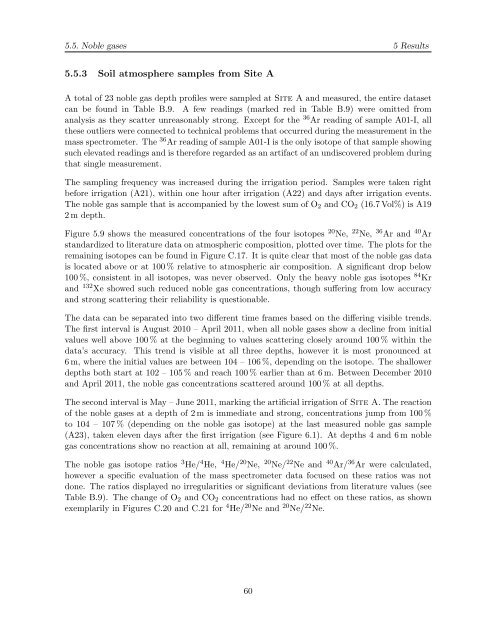Diploma thesis in Physics submitted by Florian Freundt born in ...
Diploma thesis in Physics submitted by Florian Freundt born in ...
Diploma thesis in Physics submitted by Florian Freundt born in ...
You also want an ePaper? Increase the reach of your titles
YUMPU automatically turns print PDFs into web optimized ePapers that Google loves.
5.5. Noble gases 5 Results<br />
5.5.3 Soil atmosphere samples from Site A<br />
A total of 23 noble gas depth profiles were sampled at Site A and measured, the entire dataset<br />
can be found <strong>in</strong> Table B.9. A few read<strong>in</strong>gs (marked red <strong>in</strong> Table B.9) were omitted from<br />
analysis as they scatter unreasonably strong. Except for the 36 Ar read<strong>in</strong>g of sample A01-I, all<br />
these outliers were connected to technical problems that occurred dur<strong>in</strong>g the measurement <strong>in</strong> the<br />
mass spectrometer. The 36 Ar read<strong>in</strong>g of sample A01-I is the only isotope of that sample show<strong>in</strong>g<br />
such elevated read<strong>in</strong>gs and is therefore regarded as an artifact of an undiscovered problem dur<strong>in</strong>g<br />
that s<strong>in</strong>gle measurement.<br />
The sampl<strong>in</strong>g frequency was <strong>in</strong>creased dur<strong>in</strong>g the irrigation period. Samples were taken right<br />
before irrigation (A21), with<strong>in</strong> one hour after irrigation (A22) and days after irrigation events.<br />
The noble gas sample that is accompanied <strong>by</strong> the lowest sum of O2 and CO2 (16.7 Vol%) is A19<br />
2 m depth.<br />
Figure 5.9 shows the measured concentrations of the four isotopes 20 Ne, 22 Ne, 36 Ar and 40 Ar<br />
standardized to literature data on atmospheric composition, plotted over time. The plots for the<br />
rema<strong>in</strong><strong>in</strong>g isotopes can be found <strong>in</strong> Figure C.17. It is quite clear that most of the noble gas data<br />
is located above or at 100 % relative to atmospheric air composition. A significant drop below<br />
100 %, consistent <strong>in</strong> all isotopes, was never observed. Only the heavy noble gas isotopes 84 Kr<br />
and 132 Xe showed such reduced noble gas concentrations, though suffer<strong>in</strong>g from low accuracy<br />
and strong scatter<strong>in</strong>g their reliability is questionable.<br />
The data can be separated <strong>in</strong>to two different time frames based on the differ<strong>in</strong>g visible trends.<br />
The first <strong>in</strong>terval is August 2010 – April 2011, when all noble gases show a decl<strong>in</strong>e from <strong>in</strong>itial<br />
values well above 100 % at the beg<strong>in</strong>n<strong>in</strong>g to values scatter<strong>in</strong>g closely around 100 % with<strong>in</strong> the<br />
data’s accuracy. This trend is visible at all three depths, however it is most pronounced at<br />
6 m, where the <strong>in</strong>itial values are between 104 – 106 %, depend<strong>in</strong>g on the isotope. The shallower<br />
depths both start at 102 – 105 % and reach 100 % earlier than at 6 m. Between December 2010<br />
and April 2011, the noble gas concentrations scattered around 100 % at all depths.<br />
The second <strong>in</strong>terval is May – June 2011, mark<strong>in</strong>g the artificial irrigation of Site A. The reaction<br />
of the noble gases at a depth of 2 m is immediate and strong, concentrations jump from 100 %<br />
to 104 – 107 % (depend<strong>in</strong>g on the noble gas isotope) at the last measured noble gas sample<br />
(A23), taken eleven days after the first irrigation (see Figure 6.1). At depths 4 and 6 m noble<br />
gas concentrations show no reaction at all, rema<strong>in</strong><strong>in</strong>g at around 100 %.<br />
The noble gas isotope ratios 3 He/ 4 He, 4 He/ 20 Ne, 20 Ne/ 22 Ne and 40 Ar/ 36 Ar were calculated,<br />
however a specific evaluation of the mass spectrometer data focused on these ratios was not<br />
done. The ratios displayed no irregularities or significant deviations from literature values (see<br />
Table B.9). The change of O2 and CO2 concentrations had no effect on these ratios, as shown<br />
exemplarily <strong>in</strong> Figures C.20 and C.21 for 4 He/ 20 Ne and 20 Ne/ 22 Ne.<br />
60
















